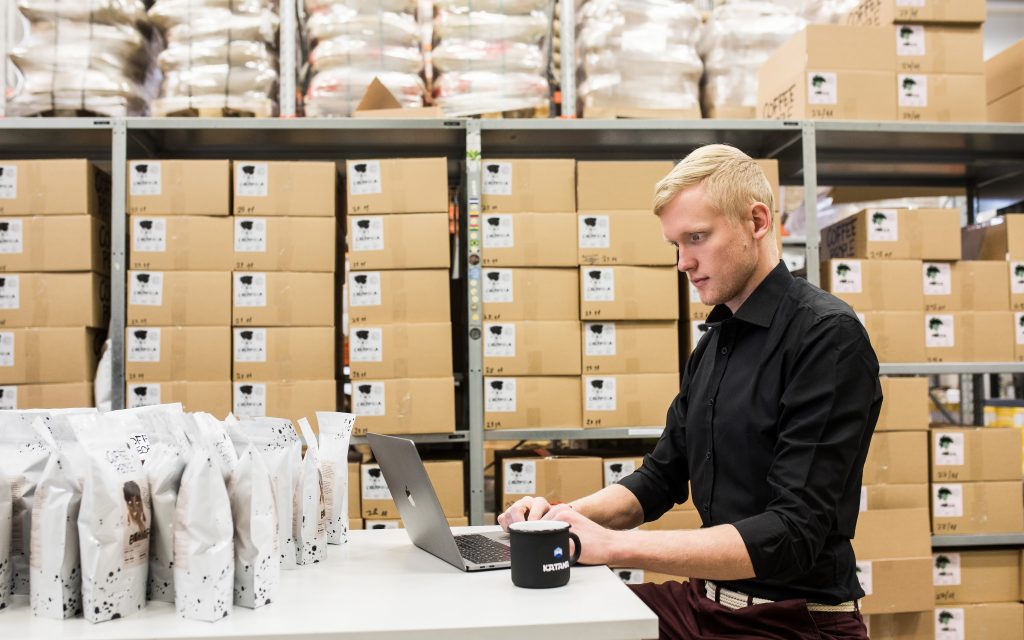Shopify POS inventory management guide (2023)
Selling Shopify products in person can help boost sales and your brand. Explore the difference a Shopify POS inventory management can have on your business.

QuickBooks raw material inventory solutions help track your entire production process for sales and manufacturing. Learn more about it here.

There’s no doubt that QuickBooks raw material inventory can be a tough nut to crack for growing manufacturers.
The problem lies in the lack of a dedicated manufacturing module. But what’s the solution? QuickBooks Online is an awesome tool when it comes to organizing your accounts and finances — there’s no arguing with that.
But there’s also no doubt that it does have its limitations.
Especially when we come to the subject of inventory management and QuickBooks raw material inventory.
As easy as it might be for resellers and drop shippers to keep track of their goods, it’s a whole different story when it comes to scaling manufacturers. Especially if you’re looking to grow your business and don’t have time to constantly be manually updating your inventory. So, what’s the issue here exactly?
Pro tip: If you are a manufacturer selling on Shopify, we’ve got you covered. Learn how to optimize production with integrated Shopify manufacturing software, maximize your sales with multiple Shopify stores, and find out the best Shopify tools to take your business to the next level.
Well, the first thing to note is that QuickBooks Online wasn’t designed to be a specialized inventory management tool in the first place.
Sure you can track your finished products as inventory items, but it’s a different story when it comes to QuickBooks Online inventory raw materials. QuickBooks Plus version offers an QuickBooks inventory management module that will give you the option to separate your stock into Inventory and Non-inventory items. Non-inventory items are meant to be used for materials.
However, the main point to note here is that QuickBooks is designed to only track your raw materials used as an expense to give you a calculation of your cost of goods sold. However, it doesn’t take into account the manufacturing costs of making a product.
For example, you handle cloth that you use to make t-shirts and picnic blankets. QuickBooks will only track the expenses of raw material used in production but don’t consider that the value changes for each operation — perhaps the lead time is longer for the picnic blanket and costs more resources to produce.
With QuickBooks online raw material inventory you’ll need to make a manual adjustment to your Non-inventory items as and when you finish using them in production.
Of course, this is incredibly inefficient and time-consuming, especially for a manufacturer whose business relies on constantly exhausting materials to make finished products. There is a workaround to this, which we will explore a little later!
And the second thing to note is the problem of not having a bill of materials (product recipes) feature. That means you cannot create a list of materials or sub-assemblies for finished products.
Without this QuickBooks Online lot tracking feature, tracking the material availability for specific products becomes a lot more cumbersome because, like the previous example, each product will have varying materials, and amounts of those materials used.
QuickBooks lacks bill of materials and tracking of material availability means that it’s very easy for you to end up making mistakes in production and purchasing.
And that’s the issue here.
QuickBooks Online just hasn’t been designed to track the manufacturing process and associated costs of your raw materials inventory effectively.
But before we look into a solution for the issue of raw material inventory management QuickBooks, how exactly do you input inventory into QuickBooks?
How to enter inventory in QuickBooks is a relatively straight forward process, even if you’re missing features needed by a manufacturing business.
However, to enter inventory into QuickBooks Online, you simply select New from the Products and Services dashboard.
From here, you can choose an Inventory Item to open a new window for the product or service you wish to enter into QuickBooks. Here you can fill out the product name and all the other relevant fields, such as:
Once you’ve finished, you can click Save to enter the item into your QuickBooks inventory system.
However, if you’re using a spreadsheet to manage your inventory, when you’re entering a product into QuickBooks Online, simply select the Import option to upload the spreadsheet into QuickBooks.
And that’s all you need to know about how to enter inventory into QuickBooks, now for the important part of the article. How do you overcome the limitations of using QuickBooks Online for raw material inventory management?

Where there’s a will, there’s a way, right?
Well kind of, but not really.
QuickBooks Online does allow you to group inventory items together. So, this way you can make sure that when a product is sold, the materials associated with that product also have their stock reduced.
The way you do this is by simply ignoring the use of Non-inventory items, and creating your materials as Products.
You can then group them together using the Bundle option and set the quantities appropriately.
Now when you sell this Bundle your materials and finished product stock will be reduced automatically.
Seems simple enough doesn’t it?
Sadly, it’s a bit too simple.
There are four issues that come up here:
Negative inventory is essentially when you generate an invoice in QuickBooks when your stock level goes below zero. This might seem unlikely, but in the fast-moving world of manufacturing, this is very common.
It happens when you fulfill a sales order without updating your QuickBooks inventory and end up in negative numbers.
Now that might seem minor, but the problem is that once your inventory goes into the negatives, QuickBooks will falsely calculate your reports and accounts. This includes your profits, COGS, cash-basis balance sheets, and QuickBooks chart of accounts for raw material inventory.
The second issue is that even when you set your materials as Inventory items in QuickBooks, they are still not going to be reduced in stock until they are sold.
Of course, what this means is that you will not have an accurate view of your material stock, because your material quantities may be showing higher than they actually are.
Even if you are an MTO business you will still have this issue because until the order is fulfilled you will be lacking insight into your material availability.
This can cause real issues with your production because you could run out of materials for sales orders without even realizing if you use raw material inventory management QuickBooks as your main reference point.
As an extension of the problem with production, you will also not know when to purchase more material in this way.
Your raw materials quantities are going to be inaccurate because many of them will already have been used in production, but not yet sold.
You may be tempted to overstock your materials to counter this problem, but that is a potentially dark road to go down. The risk of increasing your carrying costs and accumulating dead stock will increase dramatically.
Not worth it.
The final point is simply that it is just so time-consuming to set up groups for each and every one of your products. Because don’t forget that you will have to create and track an individual Bundle for every single one of your variants.
If you make twenty t-shirt designs that come in five colors each, that means a total of one hundred extra Bundles you have to create manually, and then track separately.
Katana follows your entire production process for sales and manufacturing orders from start to finish. That means that your QuickBooks raw material inventory is constantly being updated in real-time and allocated to orders separately. Never will your use of materials overlap again!
So, the question is how can we go about solving QuickBooks online raw material inventory problems?
Because as brilliant as QuickBooks can be for your accounting and finances, there’s no doubt that there are shortfalls when it comes to using QuickBooks for manufacturing.
Sure, you can do basic inventory management of your finished products, but the fact is that it’s not enough when you are constantly using materials to create those products.
You need to be able to track quantities, costs and product recipes so that your production line is running as efficiently as it can.
And that’s where Katana comes in.
Katana cloud manufacturing software is an all-in-one solution which manages your inventory, production, and sales in sync with your QuickBooks account.
This way you can follow all your sales and manufacturing orders from start to finish with our visual, color-coded dashboard without having to rely on tedious spreadsheets.
Here are some of its key features:
The main point to keep in mind is that Katana helps you do all these daily tasks so that you can instead focus on growing your manufacturing business. That means working on your improving your product and communicating with your customers.
Because although your QuickBooks raw material inventory is important, it’s only one step in making sure that your customers get the products they love delivered on time.